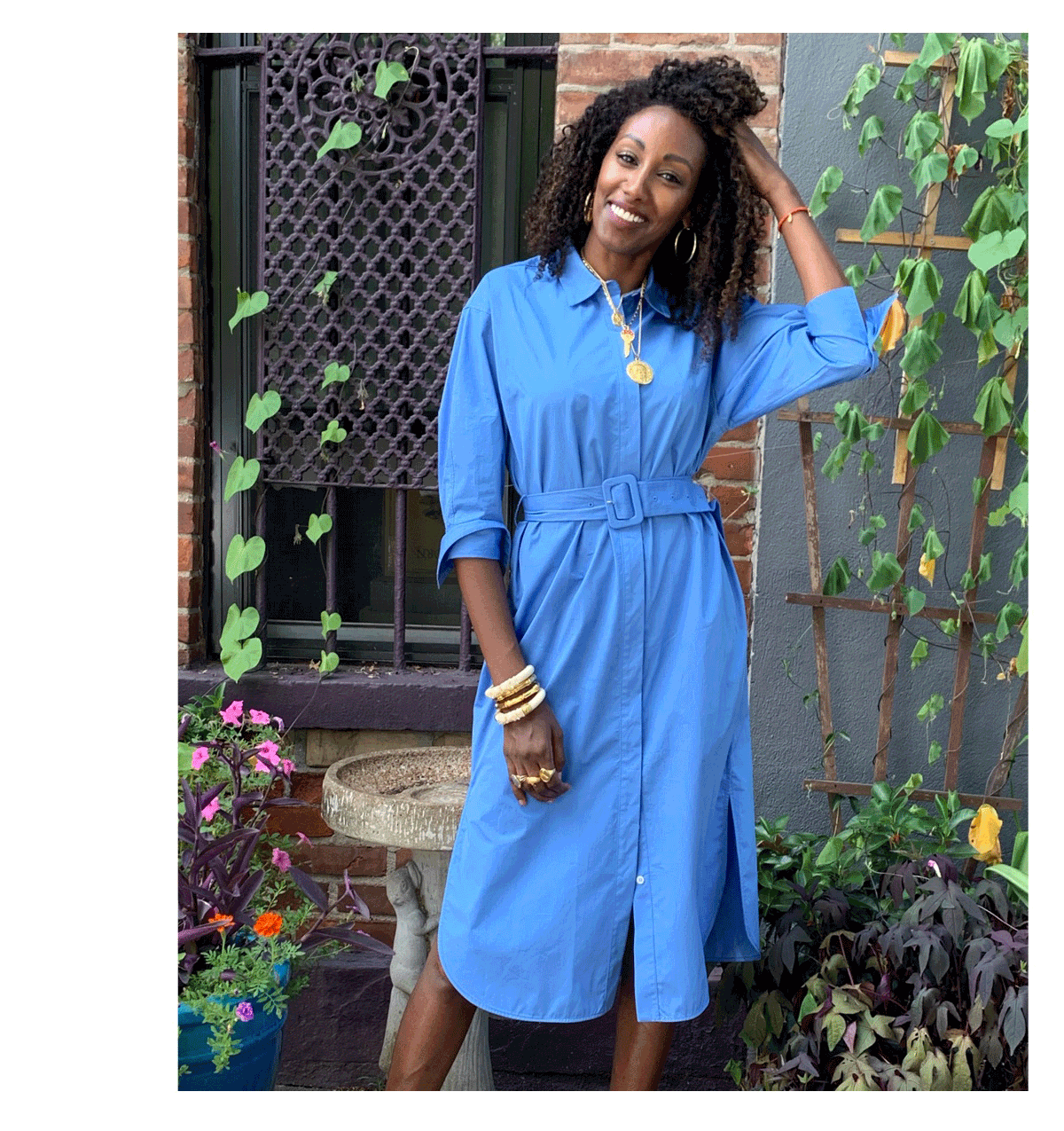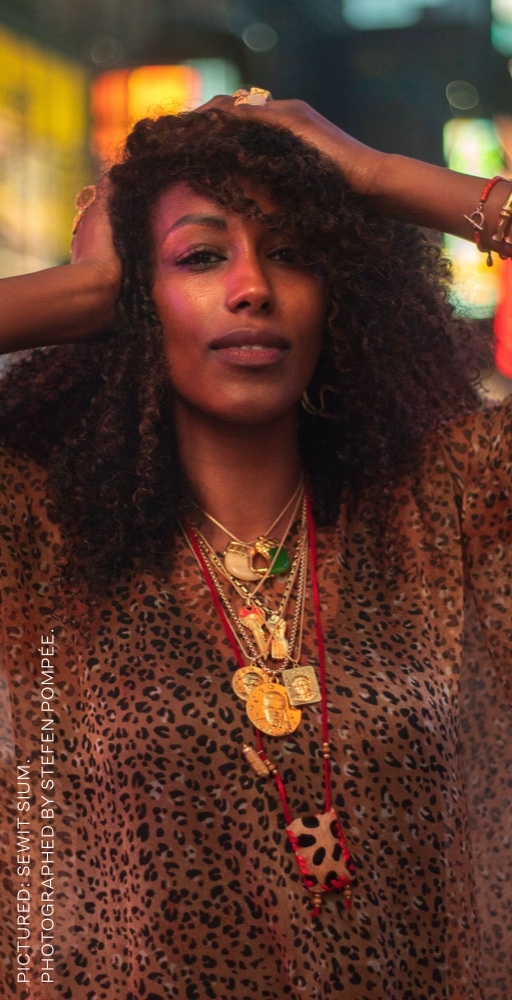
DESIGNER SPOTLIGHT
Sewit Sium
Meet the Brooklyn-based artisan seeking to educate with handcrafted jewelry that references history and her Black culture.
by Crystal Tate
“I want to tell the truth through my pieces,” says artisan and educator Sewit Sium. In 2015, she launched her eponymous line with one goal in mind: to create meaningful jewelry that goes beyond simple adornment. Sium, who is Eritrean, references her Black culture in her designs, incorporating African history and iconographies into symbolic pendants, rings, and bracelets in 18k gold vermeil. Making each piece even more personal is the fact that she crafts the jewelry herself from inside her Brooklyn home (she uses the lost-wax casting technique, which is indigenous to northeast Africa—more on that below). Her creations have garnered high praise from New York to Hollywood, with pieces featured in “Elle” and “Town & Country,” worn by celebrities including Gabrielle Union and Issa Rae—and even featured in Rae’s HBO hit show, “Insecure.” Despite the widespread recognition, Sium has remained laser focused on her mission to create positive change through her jewelry by allowing indigenous people to reclaim their motifs, symbols, and culture. “Today more than ever, but always, we need our culture for our own healing,” she says.
Below, Sium shares her inspirations, thoughts on jewelry as an educational tool, and the dangers of cultural appropriation in the fashion industry.
Below, Sium shares her inspirations, thoughts on jewelry as an educational tool, and the dangers of cultural appropriation in the fashion industry.
ON LOVING JEWELRY SINCE SHE WAS A CHILD...
Making jewelry has always been therapeutic for me from a young age. Any opportunity my parents gave me to buy clothing, I always [preferred] jewelry because it outlasts clothing and doesn’t become threadbare. It was sentimental and kept me safe. It was like a stuffed animal—but it was jewelry.
Making jewelry has always been therapeutic for me from a young age. Any opportunity my parents gave me to buy clothing, I always [preferred] jewelry because it outlasts clothing and doesn’t become threadbare. It was sentimental and kept me safe. It was like a stuffed animal—but it was jewelry.
ON WHAT INSPIRED HER TO START MAKING JEWELRY...
I’ve always loved jewelry in a very sentimental and meaningful way. Sentimentally, neither jewelry nor the memory of who gave me the jewelry will leave me. I loved my mother’s jewelry and the pieces she would bring from Eritrea. I’m East African but I was born in Toronto. My mother has a lot of heirloom jewelry that she’ll eventually pass on to me. The fact that jewelry outlasts us and goes on forever inspires me.
“The fact that jewelry outlasts us and goes
on forever inspires me.”
on forever inspires me.”
SEWIT SIUM
ON HER BLACK CULTURE IMPACTING HER DESIGNS...
I was always drawn to my culture—Black, African, and Eritrean culture—and I longed to know and learn it. Whenever I would read about it, jewelry came to mind. I ended up learning about the world through jewelry and became somewhat of a jewelry historian. By making jewelry, I learned about my culture—and learning about my history was my healing. I was learning how to navigate the world from my own perspective for once and not one that was projected onto me like in school, where I had a completely Eurocentric education—as most of us do.
ON HER INITIAL FEAR TO START A BUSINESS...
When I moved to NYC, I planned to start a handbag or jewelry line but then I started to think maybe it wasn’t for me. I was too scared to start a business. I went to NYU and I studied the politics of fashion, and how we perform our politics and identity by way of dress. Then in 2014, I felt the urge to make jewelry that I could not find or buy—meaningful jewelry that anchors me in this world and gives me a sense of pride, strength, belonging, and truth. I officially launched my line in 2015.
When I moved to NYC, I planned to start a handbag or jewelry line but then I started to think maybe it wasn’t for me. I was too scared to start a business. I went to NYU and I studied the politics of fashion, and how we perform our politics and identity by way of dress. Then in 2014, I felt the urge to make jewelry that I could not find or buy—meaningful jewelry that anchors me in this world and gives me a sense of pride, strength, belonging, and truth. I officially launched my line in 2015.
“I studied the politics of fashion, and how we perform our politics and identity by way of dress.”
SEWIT SIUM
ON CRAFTSMANSHIP...
I create my pieces with the lost-wax casting technique, using brass, gold vermeil, and sterling silver. You carve wax,make a mold of it, and then you make copies of [the original mold]. You still have to spend a long time polishing and cutting, so 50 percent of the original work happens every time you make something. The lost-wax technique is indigenous to northeast Africa. I find it really beautiful that crafting jewelry is really an ancient endeavor but it’s also a past, present, and future endeavor because our techniques really are no more sophisticated than they were 5000 years ago. That is so beautiful and I feel really connected to my roots as an Eritrean.
ON HER FAVORITE PIECE IN THE COLLECTION...
The Zula bamboo cuff . It’s one of my favorites because it’s very reminiscent of the coast of Eritrea. The foremothers and fathers of the Kemites (ancient Egyptians) were from there—they were first to the land of Punt, which was the coast of the horn of Africa and now modern-day Eritrea. It’s very lush, and there are so many palm trees and bamboo there. I wanted to make a bamboo cuff that was reminiscent of that vibe. It also has a ‘90s feel.
ON JEWELRY'S POTENTIAL TO BE AN EDUCATIONAL TOOL...
Jewelry counters the revision of history because it is documentary evidence, and it’s the catalyst for change that always has been. I’ve always been drawn to the idea that I can make something now that will outlast me. There is so much African history and so much indigenous knowledge imbued in jewelry that we can learn from and embody. It’s meant to be invoked. It’s like living history.
“Jewelry counters the revision of history
because it is documentary evidence.”
because it is documentary evidence.”
SEWIT SIUM
ON THE DANGERS OF CULTURAL APPROPRIATION IN THE FASHION INDUSTRY...
I’m anti-cultural appropriation. What happens with cultural appropriation is [brands] draw on everyone’s culture, and they’re always pulling to make money. And the [products] are not sold with their context attached to it. It’s like a blank slate and that’s branding in a sense and that’s their way of making money, but it’s dangerous because it takes away our ability to recognize our culture when we see it. Why is it OK for someone to take away the potent, indigenous context—the culture—of a piece to sell it?
And today more than ever, but always, we need our culture for our own healing and the answers to our problems as Black people and indigenous people worldwide. We’re not going to get that from somewhere other than our own culture. I truly believe indigenous people worldwide need to reclaim their iconographies, motifs, and culture, and I’ve always said that since the beginning. I truly mean that, and I believe in revolution. I want my jewelry to be an example. With my jewelry, I’m trying to throw a wrench in revisionist history and cultural appropriation.
“Today more than ever, but always, we need our culture for our own healing and the answers to our problems as Black people and indigenous people worldwide.”
SEWIT SIUM
ON HER GOALS AND WHAT'S NEXT...
Through my work, I want to create a better way for jewelry to be engaged with—holistically. Jewelry is engaged within a mainly capitalist realm and that’s a problem. I’m not interested in making things just to be sold. Where is the happiness in that? I’m trying to make a change. I am working on costume design for Black productions. I also want to be a site of education that pays homage to indigenous people worldwide. I want to create a new space for my jewelry to be engaged with, and I want to tell the truth through my pieces.
Through my work, I want to create a better way for jewelry to be engaged with—holistically. Jewelry is engaged within a mainly capitalist realm and that’s a problem. I’m not interested in making things just to be sold. Where is the happiness in that? I’m trying to make a change. I am working on costume design for Black productions. I also want to be a site of education that pays homage to indigenous people worldwide. I want to create a new space for my jewelry to be engaged with, and I want to tell the truth through my pieces.
